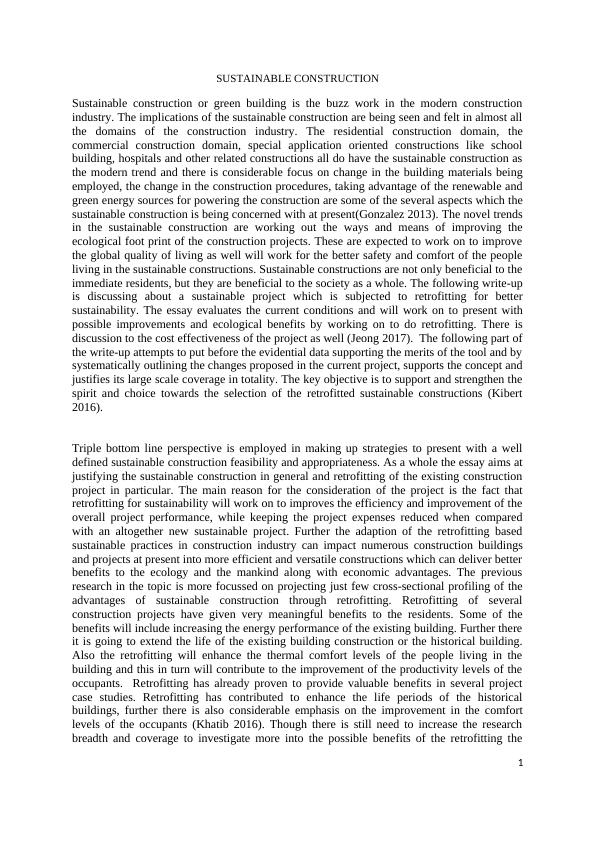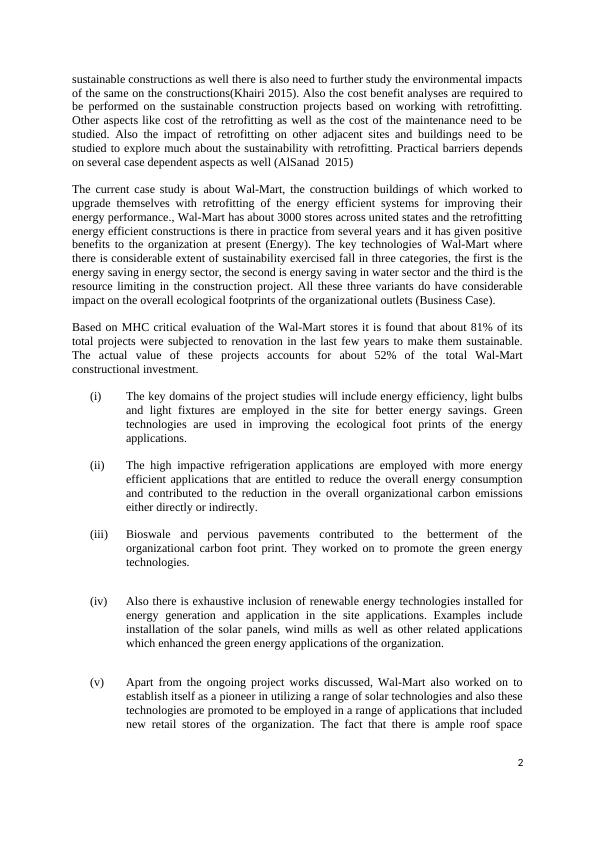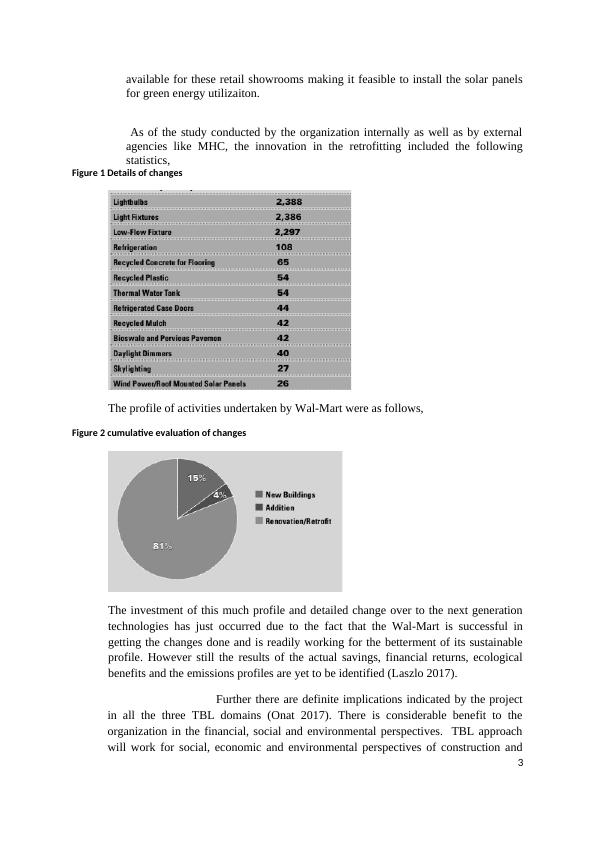Sustainable Construction and Retrofitting: A Case Study of Wal-Mart
Added on 2023-06-10
6 Pages1923 Words484 Views
SUSTAINABLE CONSTRUCTION
Sustainable construction or green building is the buzz work in the modern construction
industry. The implications of the sustainable construction are being seen and felt in almost all
the domains of the construction industry. The residential construction domain, the
commercial construction domain, special application oriented constructions like school
building, hospitals and other related constructions all do have the sustainable construction as
the modern trend and there is considerable focus on change in the building materials being
employed, the change in the construction procedures, taking advantage of the renewable and
green energy sources for powering the construction are some of the several aspects which the
sustainable construction is being concerned with at present(Gonzalez 2013). The novel trends
in the sustainable construction are working out the ways and means of improving the
ecological foot print of the construction projects. These are expected to work on to improve
the global quality of living as well will work for the better safety and comfort of the people
living in the sustainable constructions. Sustainable constructions are not only beneficial to the
immediate residents, but they are beneficial to the society as a whole. The following write-up
is discussing about a sustainable project which is subjected to retrofitting for better
sustainability. The essay evaluates the current conditions and will work on to present with
possible improvements and ecological benefits by working on to do retrofitting. There is
discussion to the cost effectiveness of the project as well (Jeong 2017). The following part of
the write-up attempts to put before the evidential data supporting the merits of the tool and by
systematically outlining the changes proposed in the current project, supports the concept and
justifies its large scale coverage in totality. The key objective is to support and strengthen the
spirit and choice towards the selection of the retrofitted sustainable constructions (Kibert
2016).
Triple bottom line perspective is employed in making up strategies to present with a well
defined sustainable construction feasibility and appropriateness. As a whole the essay aims at
justifying the sustainable construction in general and retrofitting of the existing construction
project in particular. The main reason for the consideration of the project is the fact that
retrofitting for sustainability will work on to improves the efficiency and improvement of the
overall project performance, while keeping the project expenses reduced when compared
with an altogether new sustainable project. Further the adaption of the retrofitting based
sustainable practices in construction industry can impact numerous construction buildings
and projects at present into more efficient and versatile constructions which can deliver better
benefits to the ecology and the mankind along with economic advantages. The previous
research in the topic is more focussed on projecting just few cross-sectional profiling of the
advantages of sustainable construction through retrofitting. Retrofitting of several
construction projects have given very meaningful benefits to the residents. Some of the
benefits will include increasing the energy performance of the existing building. Further there
it is going to extend the life of the existing building construction or the historical building.
Also the retrofitting will enhance the thermal comfort levels of the people living in the
building and this in turn will contribute to the improvement of the productivity levels of the
occupants. Retrofitting has already proven to provide valuable benefits in several project
case studies. Retrofitting has contributed to enhance the life periods of the historical
buildings, further there is also considerable emphasis on the improvement in the comfort
levels of the occupants (Khatib 2016). Though there is still need to increase the research
breadth and coverage to investigate more into the possible benefits of the retrofitting the
1
Sustainable construction or green building is the buzz work in the modern construction
industry. The implications of the sustainable construction are being seen and felt in almost all
the domains of the construction industry. The residential construction domain, the
commercial construction domain, special application oriented constructions like school
building, hospitals and other related constructions all do have the sustainable construction as
the modern trend and there is considerable focus on change in the building materials being
employed, the change in the construction procedures, taking advantage of the renewable and
green energy sources for powering the construction are some of the several aspects which the
sustainable construction is being concerned with at present(Gonzalez 2013). The novel trends
in the sustainable construction are working out the ways and means of improving the
ecological foot print of the construction projects. These are expected to work on to improve
the global quality of living as well will work for the better safety and comfort of the people
living in the sustainable constructions. Sustainable constructions are not only beneficial to the
immediate residents, but they are beneficial to the society as a whole. The following write-up
is discussing about a sustainable project which is subjected to retrofitting for better
sustainability. The essay evaluates the current conditions and will work on to present with
possible improvements and ecological benefits by working on to do retrofitting. There is
discussion to the cost effectiveness of the project as well (Jeong 2017). The following part of
the write-up attempts to put before the evidential data supporting the merits of the tool and by
systematically outlining the changes proposed in the current project, supports the concept and
justifies its large scale coverage in totality. The key objective is to support and strengthen the
spirit and choice towards the selection of the retrofitted sustainable constructions (Kibert
2016).
Triple bottom line perspective is employed in making up strategies to present with a well
defined sustainable construction feasibility and appropriateness. As a whole the essay aims at
justifying the sustainable construction in general and retrofitting of the existing construction
project in particular. The main reason for the consideration of the project is the fact that
retrofitting for sustainability will work on to improves the efficiency and improvement of the
overall project performance, while keeping the project expenses reduced when compared
with an altogether new sustainable project. Further the adaption of the retrofitting based
sustainable practices in construction industry can impact numerous construction buildings
and projects at present into more efficient and versatile constructions which can deliver better
benefits to the ecology and the mankind along with economic advantages. The previous
research in the topic is more focussed on projecting just few cross-sectional profiling of the
advantages of sustainable construction through retrofitting. Retrofitting of several
construction projects have given very meaningful benefits to the residents. Some of the
benefits will include increasing the energy performance of the existing building. Further there
it is going to extend the life of the existing building construction or the historical building.
Also the retrofitting will enhance the thermal comfort levels of the people living in the
building and this in turn will contribute to the improvement of the productivity levels of the
occupants. Retrofitting has already proven to provide valuable benefits in several project
case studies. Retrofitting has contributed to enhance the life periods of the historical
buildings, further there is also considerable emphasis on the improvement in the comfort
levels of the occupants (Khatib 2016). Though there is still need to increase the research
breadth and coverage to investigate more into the possible benefits of the retrofitting the
1

sustainable constructions as well there is also need to further study the environmental impacts
of the same on the constructions(Khairi 2015). Also the cost benefit analyses are required to
be performed on the sustainable construction projects based on working with retrofitting.
Other aspects like cost of the retrofitting as well as the cost of the maintenance need to be
studied. Also the impact of retrofitting on other adjacent sites and buildings need to be
studied to explore much about the sustainability with retrofitting. Practical barriers depends
on several case dependent aspects as well (AlSanad 2015)
The current case study is about Wal-Mart, the construction buildings of which worked to
upgrade themselves with retrofitting of the energy efficient systems for improving their
energy performance., Wal-Mart has about 3000 stores across united states and the retrofitting
energy efficient constructions is there in practice from several years and it has given positive
benefits to the organization at present (Energy). The key technologies of Wal-Mart where
there is considerable extent of sustainability exercised fall in three categories, the first is the
energy saving in energy sector, the second is energy saving in water sector and the third is the
resource limiting in the construction project. All these three variants do have considerable
impact on the overall ecological footprints of the organizational outlets (Business Case).
Based on MHC critical evaluation of the Wal-Mart stores it is found that about 81% of its
total projects were subjected to renovation in the last few years to make them sustainable.
The actual value of these projects accounts for about 52% of the total Wal-Mart
constructional investment.
(i) The key domains of the project studies will include energy efficiency, light bulbs
and light fixtures are employed in the site for better energy savings. Green
technologies are used in improving the ecological foot prints of the energy
applications.
(ii) The high impactive refrigeration applications are employed with more energy
efficient applications that are entitled to reduce the overall energy consumption
and contributed to the reduction in the overall organizational carbon emissions
either directly or indirectly.
(iii) Bioswale and pervious pavements contributed to the betterment of the
organizational carbon foot print. They worked on to promote the green energy
technologies.
(iv) Also there is exhaustive inclusion of renewable energy technologies installed for
energy generation and application in the site applications. Examples include
installation of the solar panels, wind mills as well as other related applications
which enhanced the green energy applications of the organization.
(v) Apart from the ongoing project works discussed, Wal-Mart also worked on to
establish itself as a pioneer in utilizing a range of solar technologies and also these
technologies are promoted to be employed in a range of applications that included
new retail stores of the organization. The fact that there is ample roof space
2
of the same on the constructions(Khairi 2015). Also the cost benefit analyses are required to
be performed on the sustainable construction projects based on working with retrofitting.
Other aspects like cost of the retrofitting as well as the cost of the maintenance need to be
studied. Also the impact of retrofitting on other adjacent sites and buildings need to be
studied to explore much about the sustainability with retrofitting. Practical barriers depends
on several case dependent aspects as well (AlSanad 2015)
The current case study is about Wal-Mart, the construction buildings of which worked to
upgrade themselves with retrofitting of the energy efficient systems for improving their
energy performance., Wal-Mart has about 3000 stores across united states and the retrofitting
energy efficient constructions is there in practice from several years and it has given positive
benefits to the organization at present (Energy). The key technologies of Wal-Mart where
there is considerable extent of sustainability exercised fall in three categories, the first is the
energy saving in energy sector, the second is energy saving in water sector and the third is the
resource limiting in the construction project. All these three variants do have considerable
impact on the overall ecological footprints of the organizational outlets (Business Case).
Based on MHC critical evaluation of the Wal-Mart stores it is found that about 81% of its
total projects were subjected to renovation in the last few years to make them sustainable.
The actual value of these projects accounts for about 52% of the total Wal-Mart
constructional investment.
(i) The key domains of the project studies will include energy efficiency, light bulbs
and light fixtures are employed in the site for better energy savings. Green
technologies are used in improving the ecological foot prints of the energy
applications.
(ii) The high impactive refrigeration applications are employed with more energy
efficient applications that are entitled to reduce the overall energy consumption
and contributed to the reduction in the overall organizational carbon emissions
either directly or indirectly.
(iii) Bioswale and pervious pavements contributed to the betterment of the
organizational carbon foot print. They worked on to promote the green energy
technologies.
(iv) Also there is exhaustive inclusion of renewable energy technologies installed for
energy generation and application in the site applications. Examples include
installation of the solar panels, wind mills as well as other related applications
which enhanced the green energy applications of the organization.
(v) Apart from the ongoing project works discussed, Wal-Mart also worked on to
establish itself as a pioneer in utilizing a range of solar technologies and also these
technologies are promoted to be employed in a range of applications that included
new retail stores of the organization. The fact that there is ample roof space
2

available for these retail showrooms making it feasible to install the solar panels
for green energy utilizaiton.
As of the study conducted by the organization internally as well as by external
agencies like MHC, the innovation in the retrofitting included the following
statistics,
Figure 1 Details of changes
The profile of activities undertaken by Wal-Mart were as follows,
Figure 2 cumulative evaluation of changes
The investment of this much profile and detailed change over to the next generation
technologies has just occurred due to the fact that the Wal-Mart is successful in
getting the changes done and is readily working for the betterment of its sustainable
profile. However still the results of the actual savings, financial returns, ecological
benefits and the emissions profiles are yet to be identified (Laszlo 2017).
Further there are definite implications indicated by the project
in all the three TBL domains (Onat 2017). There is considerable benefit to the
organization in the financial, social and environmental perspectives. TBL approach
will work for social, economic and environmental perspectives of construction and
3
for green energy utilizaiton.
As of the study conducted by the organization internally as well as by external
agencies like MHC, the innovation in the retrofitting included the following
statistics,
Figure 1 Details of changes
The profile of activities undertaken by Wal-Mart were as follows,
Figure 2 cumulative evaluation of changes
The investment of this much profile and detailed change over to the next generation
technologies has just occurred due to the fact that the Wal-Mart is successful in
getting the changes done and is readily working for the betterment of its sustainable
profile. However still the results of the actual savings, financial returns, ecological
benefits and the emissions profiles are yet to be identified (Laszlo 2017).
Further there are definite implications indicated by the project
in all the three TBL domains (Onat 2017). There is considerable benefit to the
organization in the financial, social and environmental perspectives. TBL approach
will work for social, economic and environmental perspectives of construction and
3

End of preview
Want to access all the pages? Upload your documents or become a member.
Related Documents
Sustainable Architecture - Doclg...
|10
|2525
|340
Sustainable Development in Civil Engineering: A Modern Trendlg...
|3
|689
|79
Green Consumption in UAE: A Literature Reviewlg...
|5
|966
|93
Sustainability and Buildings - Energy Savinglg...
|6
|2476
|30
Sustainability in the Construction Industrylg...
|15
|1289
|182
Case Study on Lenovo Assignmentlg...
|11
|2816
|65
